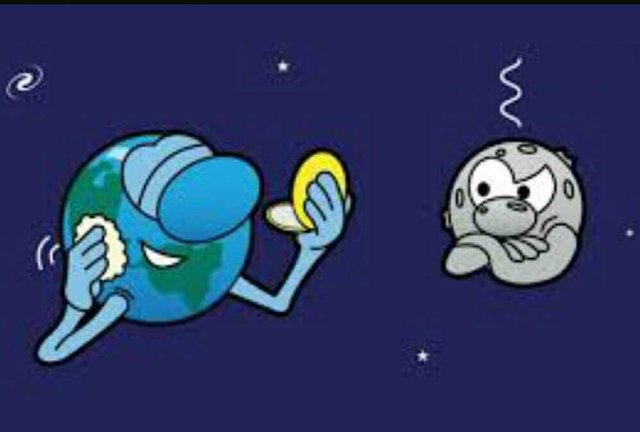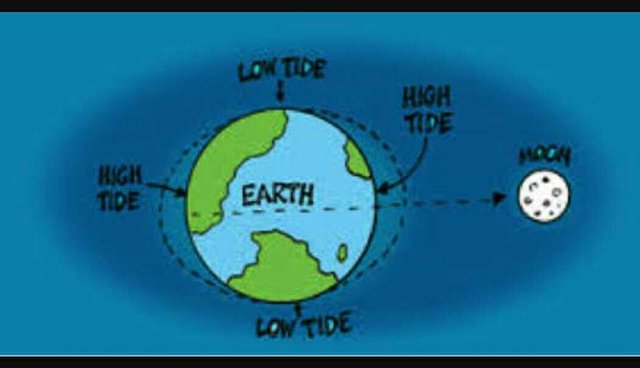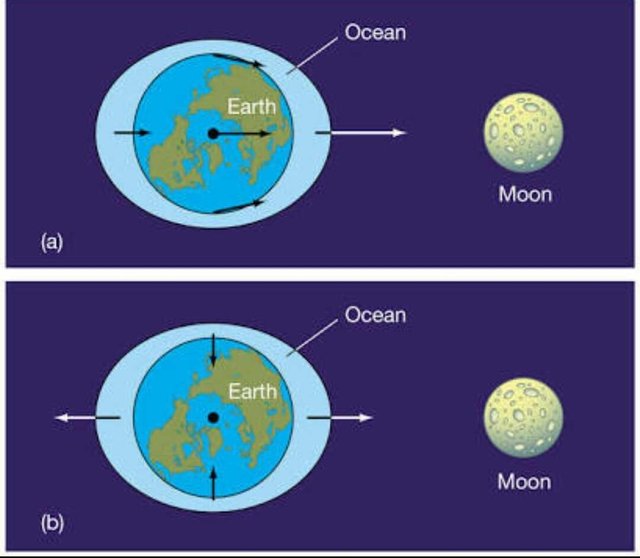Moon's effect on earth
Moon has very important impact on earth . It is more than 200000 miles away from earth . The moon and the sun combine to create tides in Earth's oceans . gravitational effect is so strong that our planet's crust is stretched daily by these same tidal effects).0

But tides are large-scale events. They occur because of the difference in gravitational effect on one side of an object (like Earth) compared to the other. Here's how tides work:

The ocean on the side of Earth facing the moon gets pulled toward the moon more than does the center of the planet. This creates a high tide. On the other side of the Earth, another high tide occurs, because the center of Earth is being pulled toward the moon more than is the ocean on the far side. The result essentially pulls the planet away from the ocean (a negative force that effectively lifts the ocean away from the planet).
However, there's no measurable difference in the moon's gravitational effect to one side of your body vs. the other. Even in a large lake, tides are extremely minor. On the Great Lakes, for example, tides never exceed 2 inches, according to the National Oceanic and Atmospheric Administration (NOAA), which adds, "These minor variations are masked by the greater fluctuations in lake levels produced by wind and barometric pressure changes. Consequently, the Great Lakes are considered to be essentially non-tidal."
That's not to say tides don't exist at smaller scales.
The effect of gravity diminishes with distance, but never goes away. So in theory everything in the universe is tugging on everything else. But: "Researchers have calculated that a mother holding her baby exerts 12 million times the tide-raising force on the child than the moon does, simply by virtue of being closer," according to Straightdope.com, a Web site that applies logic and reason to myths and urban legends.
Consider also that tides in Earth's oceans happen twice every day as Earth spins on its axis every 24 hours, bringing the moon constantly up and down in the sky. If the moon's tugging affected the human body, one might presume we'd be off balance at least twice a day (and maybe we are).
The Earth’s satellite is a spectacular sight even with the naked eye. With a small telescope or pair of binoculars, the view is even more amazing.
Dark, flat plains called maria, deep craters and bright rays of ejected material pepper the rugged surface.
As the moon orbits Earth, it always keeps one face toward the planet. The permanently hidden part is properly called the “far” side – not the “dark” side. In fact, the part of the moon that is dark changes constantly.
The part that is illuminated indicates the moon’s phase. A full cycle of phases requires 29.53 days, or a lunar month.
In 1500 there were no telescopes, but Leonardo da Vinci was able to observe that the dark part of the crescent moon still has a faint glow. He correctly surmised that this was due to reflected light from Earth.
As the moon orbits, it rocks back and forth a little, a phenomenon called libration. This allows people to see just a little bit over the edge, into the far side.
About 59 percent of the entire lunar surface is visible from Earth.
Today, the moon has been thoroughly mapped by orbiting satellites and walked upon by human visitors. Nevertheless the view of the moon from Earth is still a breathtaking sight.
It is considered likely by many authors that the current circa 23.5 degree tilt of the Earth's axis of rotation is a relic of the oblique collision that produced the Moon. Furthermore it is argued that the presence of the orbiting Moon has, through a large part of geological time, stabilised this axial tilt or obliquity of the Earth. This has had important ramifications for life on the Earth as major and frequent shifts in this obliquity would have led to significant and rapid changes in the Earth's climate due to changes in insolation values at the poles and equator. A similar mechanism has been suggested to explain the apparent contradictions in the climate record of Mars.
The current relatively moderate axial tilt of the Earth ensures that the difference in heating between the poles and equator is sufficient to promote a healthy and diverse range of climatic zones without veering from one extreme to another (e.g. Snowball Earth hypothesis). In particular, the stability of the Earth's axial tilt produced by the Moon, coupled with the break up of the Pangean supercontinent in the late Mesozoic, produced a diverse set of climate zones (with their associated ecological niches) compared with what had gone before during the time of the dinosaurs. This helped set the stage for the rise of the mammals, including Man.
Metals
Perhaps one of the least obvious but most significant contributions from the Moon to life on Earth has been the gift of workable metal deposits at the surface of the planet. Ever since the first samples of lunar rock were returned by the Apollo astronauts and the geochemical data were made available, scientists have been intrigued by the relatively high abundance of siderophile and chalcophile metals in the silicate Earth compared with the Moon. Current theory suggests that if the Earth had once been entirely molten then these metals should have been locked up in the Earth's metallic core as the Earth cooled. The current abundance of these elements in the Earth's mantle should be much lower, similar to those of the Moon (part of which was derived from the Earth's original mantle).
Computer modelling of the collision between the Earth and the Mars-sized impactor shows that the bulk of the mantle of the impacting object and a proportion of the Earth's silicate mantle were ejected into Earth orbit and coalesced to form the Moon. However, the metallic core of the impactor was not ejected into orbit but instead fell into the main body of the Earth. This impacting core material, in some models, is the 'wedding ring' of metals deposited into the Earth's silicate mantle after collision and subsequently recycled into workable ore deposits by plate tectonic processes over geological time. Without this gift of metals, the so called 'late veneer', it is very unlikely that a technological civilization could have developed on the Earth.

Thank you
With love
@joshita